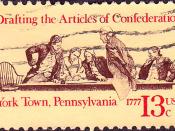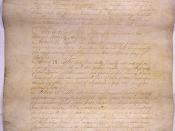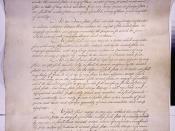DBQFrom 1781 to 1785 the Articles of Confederation provided the United States with an effective government. The main goal of the Articles was to allot as much independence as possible to the states compared to the idea of a central government for fear of conflict with Britain. Despite the many advantages of its systematic rule it did not provide enough power to the Congress in order for them to adequately control commerce, land expansion and regulate taxes. This was very expected since the Articles of Confederation were a starting point and this article was used to persuade individual states to adopt a more powerful form of government in the future.
After the ratification of the Articles of Confederation, a loose confederation was formed and granted power to a controlled extent. A house of Congress was also established which allotted each individual state one vote. Congress dealt with many important issues such as improving the military and anything relevant to homeland security, declaring wars and loaning money.
One prominent conflict was the fact that Congress does not have the adequate power to regulate commerce and trade between foreign countries. This presented a significant problem because states started enforcing individual laws of which Congress had no say in. In turn, this rendered Congress helpless in making laws regarding to taxation and tariffs. In a sense, the Americans were taking full advantage of the lenient government, often passing laws without consulting the Congress.
Many states refused to pay tax to the congress stating that it was preposterous and claiming that they saw many similarities to the policies of the British Parliament. In 1782, outspoken representatives from the Rhode Island assembly wrote a letter stating how it was ludicrous that they were subject to paying taxes to the government (Document A). Under the...


